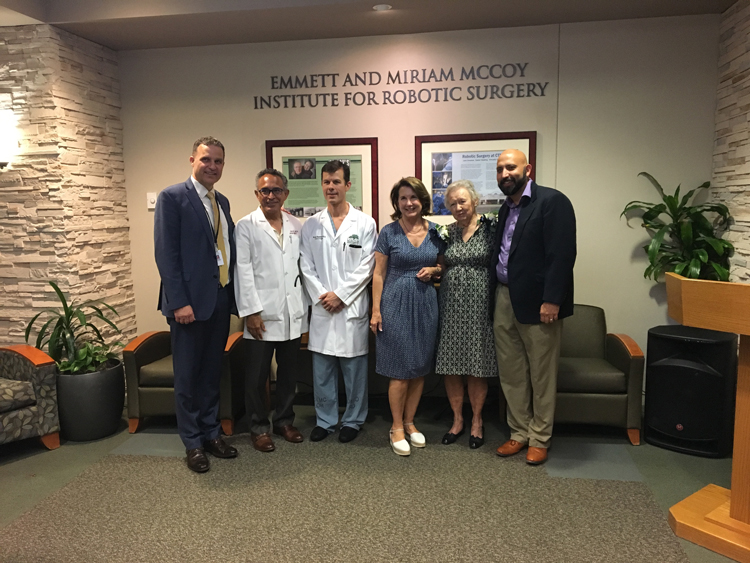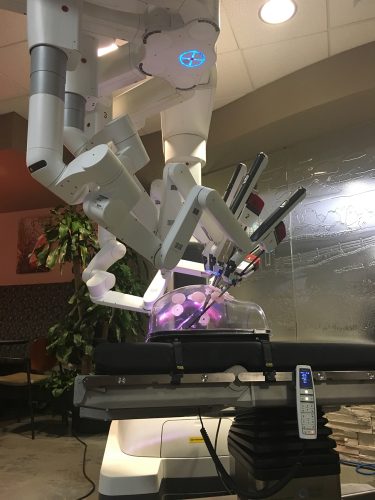
CTMC Celebrates, Welcomes Future Success With Open, Robotic Arms
![]() This Thursday, Central Texas Medical Center in San Marcos, Texas, held a special celebration to recognize one of the strongest robotic programs in the area.
This Thursday, Central Texas Medical Center in San Marcos, Texas, held a special celebration to recognize one of the strongest robotic programs in the area.
By Katlyn Brinkley
![]()
SAN MARCOS, TX – Over 2,400 patients who have visited CTMC San Marcos have been operated on by two hands, three claws and a camera.

Emmett and Miriam’s McCoy Institute for Robotic Surgery has supported the use of the da Vinci robot to perform many variations of surgery on patients.
On Wednesday, August 2, CTMC hosted an event to celebrate the success of the new da Vinci robots. The event’s focus was to recognize the hospital’s successes, which included behind-the-scenes tours of an operating room, surgeon recognition and the chance to experience a da Vinci test drive.
The da Vinci robot is a large surgical machine that is essentially made up of three major consoles—the robotic arms on the port that incise into the body, the control center that the surgeon operates in and the screen which shows what the camera inside the body is seeing.
Robotic surgery, using the da Vinci, is similar to laparoscopic surgery. A laparoscope is a small instrument that is passed through the abdominal wall, which gives physicians access to small-scale areas of the body for minor surgeries.
However, Dr. Eric Anderson, chief of surgeons at CTMC, gave the analogy that if the laparoscope was the “flip-phone” of robotic surgery, the da Vinci was the “smartphone.”
The da Vinci has more advanced features than those of the laparoscope, including clasps with “wrists” that allow the surgeon to make more sophisticated movements, as well as stronger camera magnification.
While the machine is magnificent and highly impressive, Mayor John Thomaides kicked off the celebration with recognition to the operators and the McCoy family’s donations.
“You can have great equipment, great robots, but it takes amazing physicians,” he said. “I feel so privileged to work alongside amazing, accomplished physicians.”
In 2014, the da Vinci robot was officially re-approved by the Federal Drug Administration after some recalls from the previous year were adjusted. And Anderson reported that this was the same year robotic surgery cases skyrocketed.
CTMC was “busting at the seams” with a single robot. Thanks to the McCoy family, the hospital was able to keep up with the demand from the community.
“Through the generous donation of the McCoy family we were able to bring a second unit into the hospital, so now we have two robots,” said Anderson. “We couldn’t have done it without the generosity of the McCoy Foundation.”
To prepare for the arrival of the da Vinci, nurses and physicians alike were trained to operate the robot if they elected to, and as the number of robotic surgery cases grows, so does the number of robotic trained physicians and surgeons.
“It takes quite a bit of training and proctoring to become really a robotic surgeon,” said Thomaides.
During the event, Anderson said, “The robotics program has touched over 2400 lives in this environment in just 5 short years, and our program has continued to explode. We are the busiest robotic surgery program in the corridor, between Austin and San Antonio, and we continue to grow day in and day out.”
Not only did CTMC aim to celebrate their monumental successes and partners in robotic surgery, but also to anticipate more of them in the future of this rapidly blooming industry.






